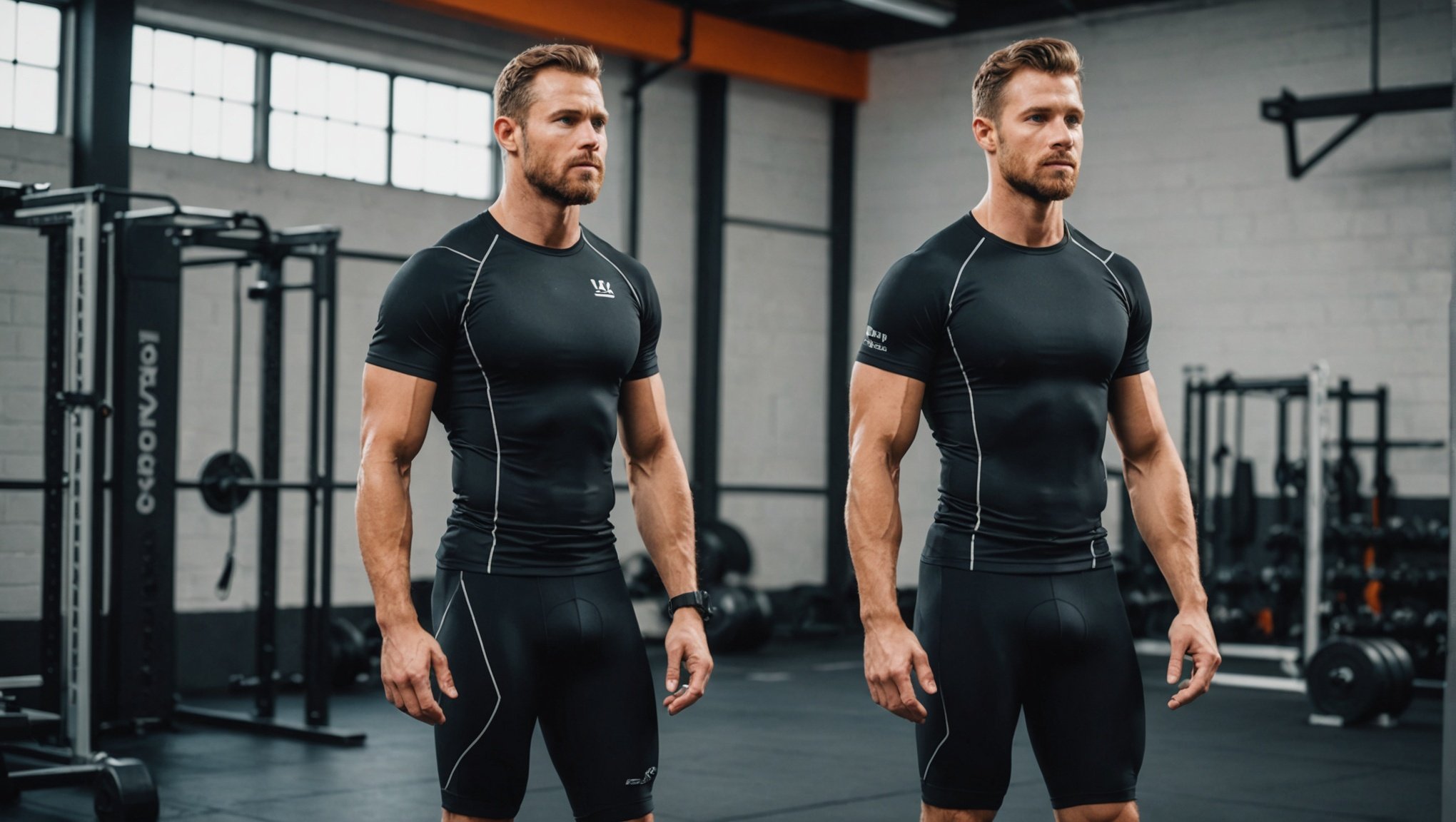Finding the right compression garment can significantly enhance your post-workout recovery. With various options available, understanding the unique benefits of each type is essential. This guide breaks down essential factors—fit, material, and targeted compression areas—helping you make an informed choice. Say goodbye to sore muscles and hello to quicker recovery. Discover how the perfect garment can transform your post-exercise routine and support your fitness goals effectively.
Understanding Compression Garments
Compression garments are specially designed clothing items that apply pressure to various parts of the body. They are crafted from elastic materials, ensuring a snug fit that supports muscle groups and enhances circulation. This definition highlights their utility in both athletic and medical contexts.
In the same genre : Mastering the Art of Styling: Elevate Bold Print Dresses with Elegant Accessories for a Harmonious Ensemble
The primary purpose of compression garments is to improve blood flow, reduce muscle fatigue, and enhance recovery post-exercise. Athletes often wear these garments during and after workouts to maintain muscle efficiency and decrease soreness. By compressing the muscles, these garments can help in stabilizing them, thus potentially reducing the risk of injury.
In fitness, compression garments are commonly used for their ability to wick away sweat, keeping the body dry and comfortable. They also provide a psychological benefit, as the tight fit can make the wearer feel more supported and confident in their movements.
Also to see : Mastering the Art of Layering: Effortlessly Shift from Office Attire to Evening Elegance
There are various types of compression garments available, catering to different needs and preferences. These include compression socks, sleeves, shirts, shorts, and full-body suits. Each type serves a specific function, whether it’s to focus on a particular muscle group or to offer full-body support. Selecting the right type of compression garment depends on individual needs and the specific activities one engages in.
Benefits of Compression Garments for Recovery
When it comes to recovery, compression garments offer a range of benefits that can significantly enhance post-exercise recuperation. By applying consistent pressure to the body, these garments effectively improve blood circulation. This increased circulation ensures that oxygen and nutrients are more efficiently delivered to muscles, which can accelerate the healing process.
One of the most notable benefits of compression garments is their ability to reduce muscle soreness and fatigue. After intense physical activity, muscles often experience micro-tears. The muscle support provided by compression garments helps to stabilize these muscles, reducing the vibrations that can lead to soreness. This stabilization not only minimizes discomfort but also aids in a quicker recovery.
Furthermore, the improved blood flow facilitated by compression garments can lead to shorter recovery times post-exercise. By promoting efficient removal of metabolic waste products, such as lactic acid, these garments help muscles recover faster, allowing athletes to return to their routines with less downtime.
Incorporating compression garments into a recovery regimen can be a practical strategy for those seeking to enhance their athletic performance and maintain muscle health. Their ability to support muscles and improve circulation makes them a valuable tool for anyone engaged in regular physical activity.
Key Factors in Choosing Compression Garments
Selecting the right compression garments involves considering several key factors that ensure optimal performance and comfort. Understanding these aspects can greatly enhance the benefits you receive from these garments.
Fit and Sizing
The fit of compression garments is crucial for their effectiveness. Proper sizing ensures that the garments apply the right amount of pressure to the body. A garment that’s too tight may restrict movement and circulation, while one that’s too loose won’t provide the necessary support. It’s important to measure your body accurately and refer to sizing charts provided by manufacturers to find the perfect fit.
Material Composition
The material of compression garments plays a significant role in their functionality. Common materials include spandex, nylon, and polyester, each offering unique benefits. Spandex provides elasticity, ensuring a snug fit. Nylon is known for its durability and moisture-wicking properties, keeping the wearer dry. Polyester offers breathability and comfort, making it ideal for prolonged use.
Level of Compression
Understanding the level of compression is essential when choosing these garments. Compression levels vary from mild to firm, each serving different purposes. Mild compression is suitable for everyday wear, while higher levels are designed for athletic performance and medical needs. Selecting the appropriate compression level depends on individual requirements and the intended use of the garment.
Comparing Popular Compression Brands
When choosing compression garments, understanding the landscape of leading brands can guide your decision. Several top brands dominate the market, each offering unique features and benefits that cater to diverse needs.
Brand Comparison is essential to identify which brand aligns with your requirements. Some leading names include Nike, Under Armour, and 2XU. Nike is renowned for its innovative fabric technology, ensuring durability and comfort. Under Armour focuses on moisture-wicking capabilities, making their garments ideal for intense workouts. 2XU, on the other hand, is celebrated for its high-performance compression levels, often preferred by professional athletes.
Features and Benefits
Each brand offers distinct features. Nike’s garments often incorporate Dri-FIT technology, enhancing breathability. Under Armour’s HeatGear material is designed to keep you cool, while 2XU’s graduated compression aids in muscle recovery.
User Reviews and Ratings
User reviews provide valuable insights into the real-world performance of these brands. Nike is frequently praised for its comfort and style. Under Armour users appreciate the fit and moisture management. 2XU generally receives high ratings for its effectiveness in reducing muscle fatigue. Evaluating these reviews can help you make an informed choice, ensuring you select the brand that best suits your needs.
User Testimonials on Compression Garments
Understanding the real-world impact of compression garments can be greatly enhanced by examining user experiences and testimonials. These firsthand accounts provide valuable insights into how these garments perform in various settings.
Testimonials often highlight the significant role these garments play in workout recovery. Many users report a noticeable reduction in muscle soreness and fatigue, attributing this to the improved blood circulation and muscle support provided by the garments. This feedback aligns with the benefits outlined by experts, reinforcing their effectiveness.
Common feedback themes include the enhanced comfort and confidence users feel during physical activities. The snug fit of compression garments helps many individuals feel more secure in their movements, boosting overall performance. Additionally, the moisture-wicking properties are frequently praised for keeping users dry and comfortable, even during intense workouts.
In terms of user experiences, some individuals note that finding the right fit is crucial for maximizing benefits. A well-fitted garment ensures optimal pressure and support, enhancing the overall experience.
These testimonials underscore the practical advantages of incorporating compression garments into fitness routines, offering a blend of physical support and psychological reassurance that many users find invaluable.
Expert Recommendations for Compression Garments
Gaining insights from fitness professionals and physiotherapists can greatly enhance your experience with compression garments. These experts often emphasize the importance of selecting garments that cater to your specific needs, whether for athletic performance or post-exercise recovery.
Professional Insights
Physiotherapists recommend focusing on the level of compression and the specific area of support needed. For example, those recovering from leg injuries might benefit from compression socks or sleeves, which target lower limb circulation. Fitness professionals suggest incorporating garments into your routine by wearing them during workouts and recovery phases to maximize benefits.
Recommended Brands and Products
Experts often highlight brands like 2XU, Nike, and Under Armour for their innovative designs and proven efficacy. 2XU is frequently recommended for its high-performance compression, ideal for professional athletes. Nike and Under Armour are praised for their comfort and moisture-wicking properties, supporting both casual and intense workouts.
Tips for Incorporation
To effectively integrate compression garments into your routine, consider the following:
- Wear during and after workouts to support muscle stability and recovery.
- Choose garments based on the specific muscle groups you wish to target.
- Consult with professionals to tailor your choice to your fitness goals and needs.
Practical Buying Guide for Compression Garments
Navigating the world of compression garments can be daunting, but with a strategic approach, you can make informed purchases. This buying guide will help you identify quality items and make the best choices for your needs.
Where to Buy Quality Compression Garments
Quality compression garments are available from various retailers, both online and in physical stores. Specialty sports stores often stock high-performance options, while online platforms like Amazon provide a wide range of choices. It’s crucial to purchase from reputable sellers to ensure authenticity and quality.
Important Factors to Check Before Purchasing
When selecting compression garments, consider the material composition, fit, and level of compression. Ensure the material is breathable and durable. Proper fit is essential for effectiveness, so consult sizing charts carefully. The level of compression should align with your intended use, whether for everyday wear or specific athletic activities.
Cost Considerations and Budget-Friendly Options
Compression garments vary in price, with high-end brands offering premium features. However, budget-friendly options are available that still provide excellent support and comfort. Look for sales or discounts, especially from well-known brands, to find quality garments at a reduced cost. Balancing cost with the desired features will help you make a wise investment.
Tips for Effective Use of Compression Garments
To maximise the benefits of compression garments, understanding their effective use is essential. Here are some guidelines to help you get the most out of your garments.
Best Practices for Wearing
For optimal results, ensure your compression garments fit snugly but comfortably. They should not be too tight as this can impede circulation. It’s advisable to wear them during and after workouts to support muscle recovery and reduce fatigue.
Duration and Timing
Timing is crucial for effective use. Wearing compression garments for a few hours post-exercise can enhance recovery by improving blood flow and reducing muscle soreness. However, avoid wearing them for extended periods, as this could lead to discomfort.
Care and Maintenance
Proper care extends the lifespan of your garments. Wash them in cold water and avoid using fabric softeners or bleach, which can degrade the material. Air drying is recommended to maintain elasticity and fit.
By following these tips, you can ensure your compression garments provide the support and recovery benefits you’re seeking, enhancing your overall fitness experience.
Conclusion and Future Trends in Compression Technology
Compression technology is on the brink of exciting innovations that promise to reshape the landscape of fitness and wellness. As we look to the future, emerging technologies are set to enhance the functionality and effectiveness of compression garments.
One significant trend is the integration of smart textiles. These advanced materials can monitor physiological data, providing real-time feedback on muscle performance and recovery. Such innovations could revolutionise how athletes and fitness enthusiasts approach their training and recovery processes.
In the realm of fitness recovery, future trends suggest a shift towards more personalised compression solutions. Customised garments, tailored to individual body shapes and specific muscle groups, will offer targeted support and improved recovery outcomes. This personalised approach is expected to enhance overall athletic performance and reduce injury risks.
Furthermore, the evolving role of compression in sports and wellness is expanding beyond traditional applications. Compression garments are increasingly being used in everyday wellness routines, offering benefits such as improved circulation and muscle support in non-athletic contexts. As the technology advances, we can anticipate broader applications and increased accessibility, making compression technology a staple in both athletic and wellness spheres.













